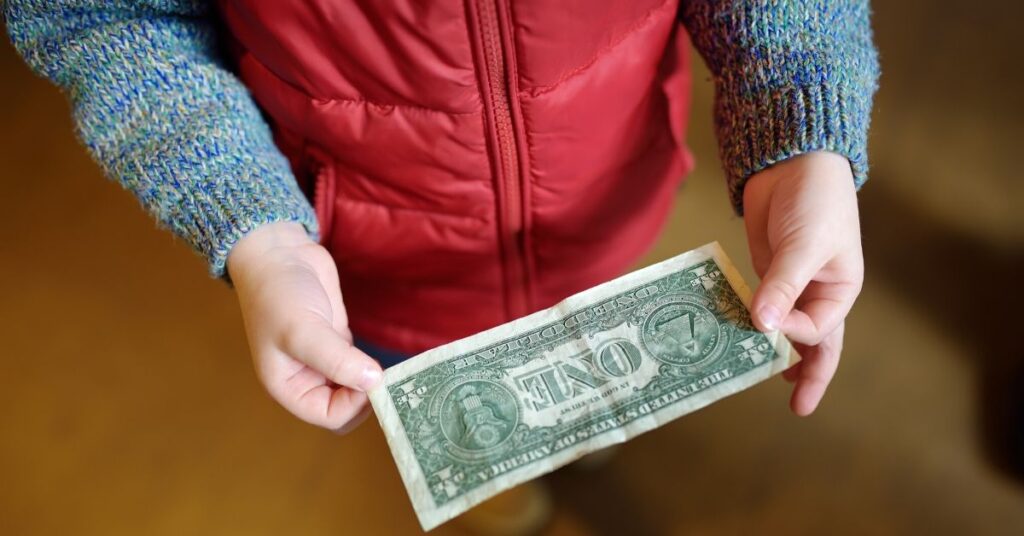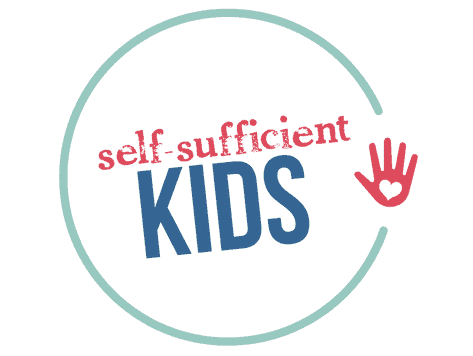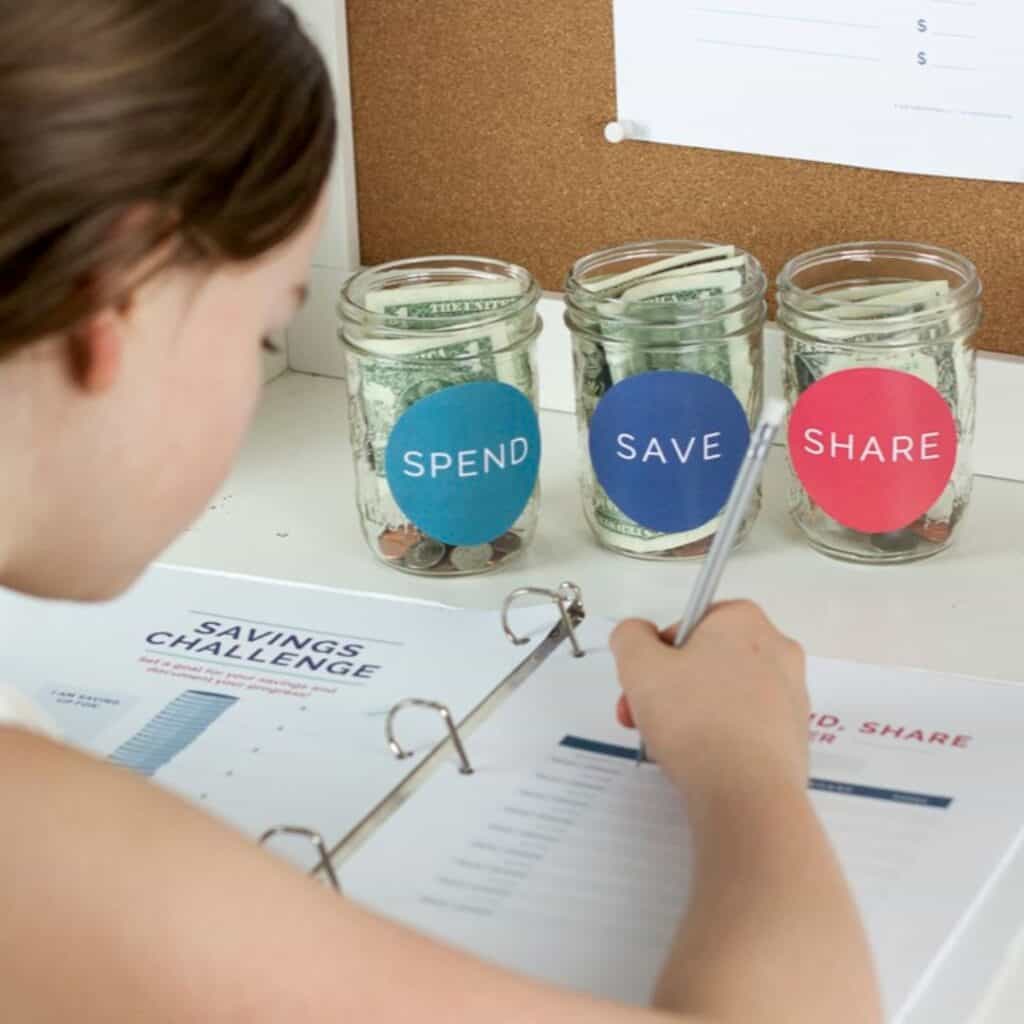How to Get Started on Kids Allowance – the Right Way
An allowance can teach kids valuable money management skills. But you may wonder how to get started. This guide can help.

You’ve taught your kids to ride a bike, to tie their shoes, and even a few cooking skills.
But have you introduced them to one of the most important life skills of all: how to manage money?
Unlike any other skill we teach our kids, knowing how to manage money could literally make or break their adulthood.
I’ve met financially-insecure people who make six-figure salaries. And I’ve also met people with modest incomes who are debt-free and have a healthy nest egg.
The difference is these people’s ability to set a budget, avoid debt, save for a goal, and understand other money basics.
Fortunately, there’s a simple tool that can give our kids the hands-on learning experience they need: an allowance.
How to set up a kids allowance – the RIGHT way
Experts agree that giving kids an allowance can teach them a number of skills that will serve them well in adulthood. But only if the allowance has the right expectations and parameters.
Here’s how to begin:
Once kids know how to add and subtract, you can give them an allowance
Money lessons can start as early as kindergarten or first grade – whenever your child learns how to add and subtract. Once children can do this basic math, they’ll have a better sense of how much money they’re actually spending or saving.
Decide which expenses your child will now be responsible for
An important way to make allowance a tool for learning is to give your child expenses they’re responsible for.
For little kids it doesn’t have to be much – toys, art and craft supplies, Legos, or books. Basically, anything that isn’t an essential purchase your child can be expected to pay for.
As kids get older, they can take on more essential expenses such as clothing, data plans, or gas for the car.
Be sure to discuss this expectation with your children before beginning allowance. It can be helpful to have it written in a contract so no one forgets the agreement.
Decide how much your child will receive and when
Once you’ve determined which expenses your child will now manage, you can determine how much money he or she should receive.
For younger kids, the amount is a little arbitrary since their purchases aren’t essential. A good rule of thumb is to give half the child’s age in dollars once a week.
Older kids will need to have enough to reasonably cover the costs they’re now responsible for, while also having just enough for discretionary purchases like going to a movie or concert with friends.
The idea is to give them enough that saving isn’t too difficult, but not so much that it’s easy for them to get everything they want.
Write out a contract with your kids
You’ve heard of the contract parents create with their kids to set expectations for screen use. It can be helpful to also have a contract for allowance so parents and kids stay on the same page. This document can be referenced when any misunderstanding comes up regarding who is responsible for which expenses.
Start off with physical money
Most transactions are digital today, but the problem with kids only using digital money is that it’s too abstract.
When learning math, research shows that kids learn best if they can begin with concrete examples such as counting blocks. The same is true with money. Kids will better understand money if they’re first exposed to physical currency and then move to abstract digital currency.
This means that as kids are getting started with allowance, it’s a good idea to give it to them in bills and coins. Being able to experience money as concrete also makes it clear to children that it is finite and has limits – a good frame of mind when making spending decisions.
Separate money into “spend,” “save” and “share” jars
Giving kids an allowance is also a chance to teach them values.
For example, assuming you agree that saving and donating money is important, you can create separate jars for money that is to be spent, saved, and given away.
Then, each time you give your child their allowance, have them place your agreed-upon amount in each jar. For example, 10% in the Share jar, 20% in the Save jar, and the rest in the Spend jar.
Doing this every time they receive their allowance, kids learn that money should be saved and shared, not just spent.
The Kids Money Management Toolkit has everything you need (except money!) to begin giving your kids an allowance. In addition to guidance and advice, you’ll also receive Save, Spend, and Share jar labels, a Kids Money Ledger, a Savings Challenge Sheet, a Jobs-for-Hire Sheet, and a Kids Allowance Contract. Click here to learn more.
Don’t connect allowance with chores or good behavior
Allowance is a tool for kids to learn money management. If it’s tied chores or good behavior, it can diminish the learning experience for kids.
Furthermore, if kids get money for chores, two things could happen. First, there may come a time when a child decides doing chores isn’t worth receiving an allowance anymore. If this happens, your child will miss out on learning valuable money management skills.
Secondly, if your child is paid for chores, he or she may eventually ask to be paid for anything. Knowing that they’re paid to do standard housework, your child may also ask to be paid to pick up their room or help make dinner, for example. Which certainly is not ideal!
For more on why it’s not a good idea to tie allowance and chores see: How to Motivate Kids to Do Chores – Without Paying Them
If kids want more money, let them earn it
Most experts discourage paying kids for routine household chores (see above). However, it’s still a good idea to let kids earn money.
For young kids, parents can have them do jobs for hire, or rather, jobs that are age-appropriate and something that the parent might otherwise have hired an outside company or contractor to do.
Older kids and teens can try to find employment outside of the home such as babysitting, mowing lawns or lifeguarding.
To see more money-making ideas for kids see: How to Make Money as a Kid: 70+ Business Ideas for Kids and Teens
Wait and see what happens next
Your child’s grasp of money management won’t be realized tomorrow, or even possibly a year from now.
They’re going to make a lot of mistakes – such as overspending, or buying a cheap trinket that breaks a day after purchase.
But these mistakes are good. They teach kids important lessons. Lessons they might have learned later in life when the stakes are higher and difficult to recover from.
There will be times when you cringe as your daughter spends all her savings on a talking bear. A toy you know she’ll be bored with in a week.
At other times, you’ll have to hold firm to your agreement that your teen is responsible for buying her own clothing. Even if she overspends on a few items and ends up with too few clothes.
But eventually, you’ll begin to see your kids make wise spending choices, become aware of what’s a good price and what’s too expensive, and hold off on impulse buys in favor of placing that money in savings.
And better yet, you’ll see them head off to college or post-high school employment equipped with valuable skills that will pay off (pun intended) for years to come.
See related:
12 of the Best Money Games for Kids
Kids Won’t Really Understand Money Until You do This
Teaching Kids to Delay Gratification in a “Buy Now, Pay Later” World
9 Mistakes to Avoid When Giving Kids an Allowance
What to do next…
1. Subscribe to Self-Sufficient Kids’ email list.
Like what you read here and want to learn more? Every Thursday I’ll send you one parenting tip about raising self-sufficient kids and creating the peaceful relationship you yearn to have with your child. Click here to sign up.
2. Take one of my quizzes!
Find out if you’re raising a self-sufficient kid (click here) or if you’re doing too much for your kids (click here). At the end of each quiz, you’ll be asked to provide your email address to see the results.
3. Get your kids started on chores.
Learn how to get your child started on chores (& keep them motivated + avoid power struggles) by enrolling in my Get Your Kids Successfully Started on Chores course. Click here to learn more and sign up.
About the Author


Kerry Flatley is the owner and author of Self-Sufficient Kids. She has a BA in economics, an MBA, a certificate in financial planning, and has been investing ever since she landed her first job. Kerry also has two girls, ages 13 and 15, who have been receiving allowance – and learning money management – for the past seven years.

